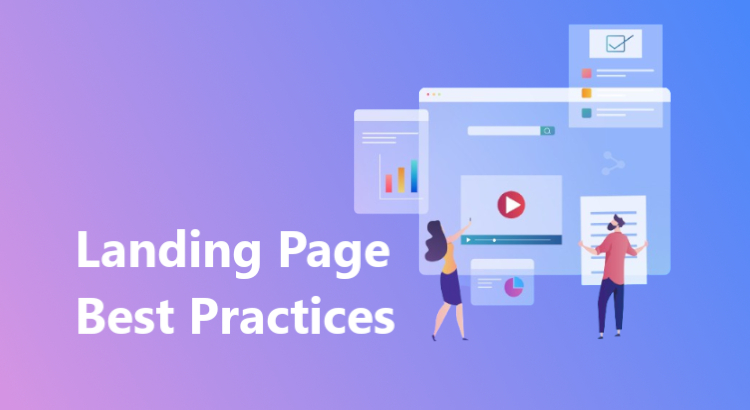Landing pages are crucial web elements that serve as gateways to user interaction, demanding a delicate balance of design, content, and strategy. This article delves into landing page best practices, dissecting the art and science behind their creation for optimal engagement and conversion rates.
Related Article: Conversion Rate Optimization: Turning Clicks into Customers for Small Businesses
What is a Landing Page?
A landing page is a standalone web page designed for a specific marketing campaign or objective. Unlike other pages on a website, a landing page is crafted with a singular focus – to encourage visitors to take a particular action, such as making a purchase, signing up for a newsletter, or downloading a resource.
How Does a Landing Page Impact Digital Marketing?
A landing page serves as a crucial tool in the digital marketer’s arsenal. Its effectiveness can significantly impact conversion rates, providing a streamlined and targeted experience for users.
By aligning with campaign goals, a well-optimized landing page maximizes the chances of turning casual visitors into engaged customers, thus enhancing the overall success of a marketing strategy.
15 Landing Page Best Practices
Check out the list of 15 landing page best practices.
1. Use a Landing Page Template
Utilize professionally designed templates for visually appealing layouts. Templates streamline design, saving time and ensuring a cohesive, user-friendly appearance that aligns with your brand.
2. Get to Know Your Audience
Tailor your content to resonate with your target audience. Understanding their preferences, needs, and pain points allows you to create a more personalized and engaging experience.
3. Define the Goal of Your Landing Page
Clearly articulate the purpose of your landing page. Whether it’s to generate leads, sell a product, or promote an event, a well-defined goal guides your design and content decisions effectively.
4. Craft a Compelling CTA
Create a clear and compelling Call-to-Action (CTA). The CTA should be concise, persuasive, and directly guide users toward the desired action, improving the overall conversion rate.
5. Use Design to Direct the Eye
Incorporate strategic design elements that guide users’ attention. Contrast, colors, and directional cues can direct focus to key areas, ensuring visitors don’t miss crucial information. If your current landing page design doesn’t comply with these principles, consider a website redesign.
Useful Article: Website Redesign Checklist: A Step-by-Step Guide for Success
6. Put the Essentials Above the Fold
Place essential information, such as the main headline and CTA, above the fold. Grab visitors’ attention immediately, encouraging them to engage further without the need to scroll.
7. Eliminate Distractions
Remove unnecessary elements that might divert attention from your primary goal. A clean and focused landing page minimizes distractions, improving the chances of conversion.
8. Keep Your Content Lean
Present concise and relevant content. Avoid information overload, ensuring that the content effectively communicates your message without overwhelming the visitor. Experienced content writers can create the perfect content for your landing page.
9. Focus on Your Value Proposition
Clearly communicate the unique value your product or service offers. Highlight benefits to address user needs, making it evident why they should choose your offering.
10. Leverage Social Proof
Incorporate testimonials, reviews, or user-generated content. Social proof builds trust and credibility, assuring hesitant visitors of the positive experiences others have had with your product or service.
11. Optimize for SEO
Incorporate relevant keywords to improve your landing page’s search engine visibility. SEO optimization attracts organic traffic, enhancing the overall reach and impact of your campaign.
Useful Article: SEO Web Design: How to Build a Search Engine Friendly Website
12. Maintain a Conversational Tone
Connect with your audience using a conversational and relatable tone. Humanizing your brand fosters trust and makes your message more accessible, increasing the likelihood of engagement.
13. Make It Mobile-Friendly
Optimize your landing page for various screen sizes. A seamless mobile experience ensures accessibility, catering to a broader audience and improving user satisfaction.
Related Article: Importance of Mobile Optimization for Elevating Your Website Experience
14. Focus Headlines on the End Result
Create compelling headlines that emphasize the benefits users will gain by taking the desired action. Clearly communicate the end result of their engagement to captivate interest.
15. A/B Test Everything
Continuously refine your landing page through A/B testing. Experiment with different elements, such as headlines, images, or CTAs, to identify what resonates best with your audience and improves conversion rates.
Closing Notes on Landing Page Best Practices
A carefully developed landing page can be the cornerstone of your website success. By implementing these landing page best practices, marketers can create engaging, user-centric experiences that not only capture attention but also drive high conversion rates.


